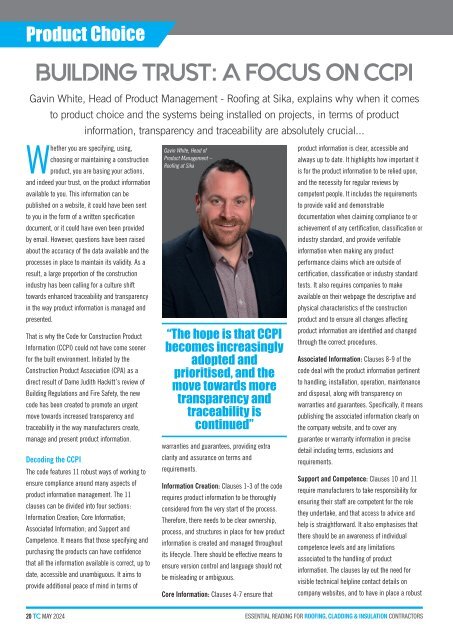May 2024
You also want an ePaper? Increase the reach of your titles
YUMPU automatically turns print PDFs into web optimized ePapers that Google loves.
Product Choice<br />
BUILDING TRUST: A FOCUS ON CCPI<br />
Gavin White, Head of Product Management - Roofing at Sika, explains why when it comes<br />
to product choice and the systems being installed on projects, in terms of product<br />
information, transparency and traceability are absolutely crucial...<br />
Whether you are specifying, using,<br />
choosing or maintaining a construction<br />
product, you are basing your actions,<br />
and indeed your trust, on the product information<br />
available to you. This information can be<br />
published on a website, it could have been sent<br />
to you in the form of a written specification<br />
document, or it could have even been provided<br />
by email. However, questions have been raised<br />
about the accuracy of the data available and the<br />
processes in place to maintain its validity. As a<br />
result, a large proportion of the construction<br />
industry has been calling for a culture shift<br />
towards enhanced traceability and transparency<br />
in the way product information is managed and<br />
presented.<br />
That is why the Code for Construction Product<br />
Information (CCPI) could not have come sooner<br />
for the built environment. Initiated by the<br />
Construction Product Association (CPA) as a<br />
direct result of Dame Judith Hackitt’s review of<br />
Building Regulations and Fire Safety, the new<br />
code has been created to promote an urgent<br />
move towards increased transparency and<br />
traceability in the way manufacturers create,<br />
manage and present product information.<br />
Decoding the CCPI<br />
The code features 11 robust ways of working to<br />
ensure compliance around many aspects of<br />
product information management. The 11<br />
clauses can be divided into four sections:<br />
Information Creation; Core Information;<br />
Associated Information; and Support and<br />
Competence. It means that those specifying and<br />
purchasing the products can have confidence<br />
that all the information available is correct, up to<br />
date, accessible and unambiguous. It aims to<br />
provide additional peace of mind in terms of<br />
Gavin White, Head of<br />
Product Management –<br />
Roofing at Sika<br />
“The hope is that CCPI<br />
becomes increasingly<br />
adopted and<br />
prioritised, and the<br />
move towards more<br />
transparency and<br />
traceability is<br />
continued”<br />
warranties and guarantees, providing extra<br />
clarity and assurance on terms and<br />
requirements.<br />
Information Creation: Clauses 1-3 of the code<br />
requires product information to be thoroughly<br />
considered from the very start of the process.<br />
Therefore, there needs to be clear ownership,<br />
process, and structures in place for how product<br />
information is created and managed throughout<br />
its lifecycle. There should be effective means to<br />
ensure version control and language should not<br />
be misleading or ambiguous.<br />
Core Information: Clauses 4-7 ensure that<br />
product information is clear, accessible and<br />
always up to date. It highlights how important it<br />
is for the product information to be relied upon,<br />
and the necessity for regular reviews by<br />
competent people. It includes the requirements<br />
to provide valid and demonstrable<br />
documentation when claiming compliance to or<br />
achievement of any certification, classification or<br />
industry standard, and provide verifiable<br />
information when making any product<br />
performance claims which are outside of<br />
certification, classification or industry standard<br />
tests. It also requires companies to make<br />
available on their webpage the descriptive and<br />
physical characteristics of the construction<br />
product and to ensure all changes affecting<br />
product information are identified and changed<br />
through the correct procedures.<br />
Associated Information: Clauses 8-9 of the<br />
code deal with the product information pertinent<br />
to handling, installation, operation, maintenance<br />
and disposal, along with transparency on<br />
warranties and guarantees. Specifically, it means<br />
publishing the associated information clearly on<br />
the company website, and to cover any<br />
guarantee or warranty information in precise<br />
detail including terms, exclusions and<br />
requirements.<br />
Support and Competence: Clauses 10 and 11<br />
require manufacturers to take responsibility for<br />
ensuring their staff are competent for the role<br />
they undertake, and that access to advice and<br />
help is straightforward. It also emphasises that<br />
there should be an awareness of individual<br />
competence levels and any limitations<br />
associated to the handling of product<br />
information. The clauses lay out the need for<br />
visible technical helpline contact details on<br />
company websites, and to have in place a robust<br />
20 TC MAY <strong>2024</strong>
















